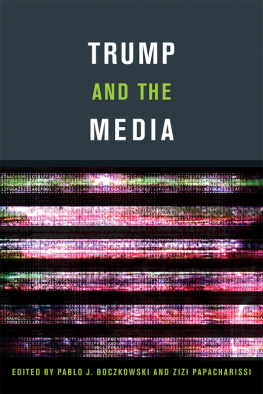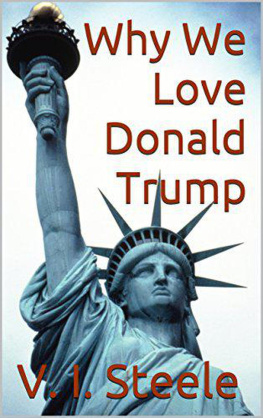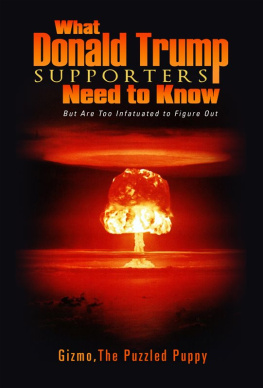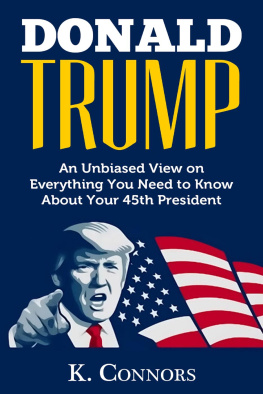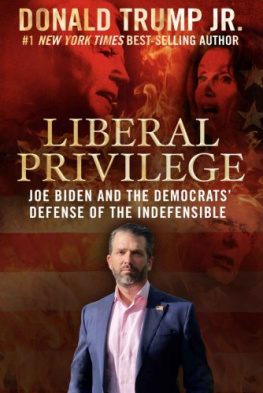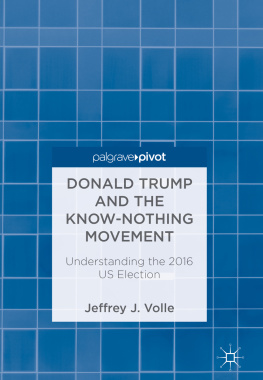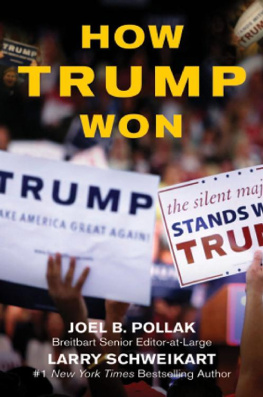Boczkowski Pablo J. - Trump and the Media
Here you can read online Boczkowski Pablo J. - Trump and the Media full text of the book (entire story) in english for free. Download pdf and epub, get meaning, cover and reviews about this ebook. year: 2018, publisher: MIT Press, genre: Politics. Description of the work, (preface) as well as reviews are available. Best literature library LitArk.com created for fans of good reading and offers a wide selection of genres:
Romance novel
Science fiction
Adventure
Detective
Science
History
Home and family
Prose
Art
Politics
Computer
Non-fiction
Religion
Business
Children
Humor
Choose a favorite category and find really read worthwhile books. Enjoy immersion in the world of imagination, feel the emotions of the characters or learn something new for yourself, make an fascinating discovery.
- Book:Trump and the Media
- Author:
- Publisher:MIT Press
- Genre:
- Year:2018
- Rating:3 / 5
- Favourites:Add to favourites
- Your mark:
- 60
- 1
- 2
- 3
- 4
- 5
Trump and the Media: summary, description and annotation
We offer to read an annotation, description, summary or preface (depends on what the author of the book "Trump and the Media" wrote himself). If you haven't found the necessary information about the book — write in the comments, we will try to find it.
Trump and the Media — read online for free the complete book (whole text) full work
Below is the text of the book, divided by pages. System saving the place of the last page read, allows you to conveniently read the book "Trump and the Media" online for free, without having to search again every time where you left off. Put a bookmark, and you can go to the page where you finished reading at any time.
Font size:
Interval:
Bookmark:
Edited by Pablo J. Boczkowski and Zizi Papacharissi
The MIT Press
Cambridge, Massachusetts
London, England
2018 Massachusetts Institute of Technology
All rights reserved. No part of this book may be reproduced in any form by any electronic or mechanical means (including photocopying, recording, or information storage and retrieval) without permission in writing from the publisher.
This book was set in ITC Stone Sans Std and ITC Stone Serif Std by Toppan Best-set Premedia Limited. Printed and bound in the United States of America.
Library of Congress Cataloging-in-Publication Data is available.
ISBN: 978-0-262-03796-9
eISBN: 9780262346603
ePub Version 1.0
It always takes a village. But sometimes more than others. This was one of those times. This book took six months from conception to final delivery of the manuscript, which is quite a feat for scholarly publishing. This would not have happened if it were not for the support and contributions of a large number of people.
We are extremely grateful to our editor at the MIT Press, Gita Manaktala. Her unfailing commitment to this project from the very first email exchange, her insightful advice at every step of the way, and her always warm presence have made our collaboration not only possible but also a true pleasure.
Our authors were a blessing to work with. They trusted us to shepherd a project that was unique not only because of its fast production cycle but also for the unusual genre format we asked them to work witha 2,500-word essay, something of hybrid between an op-ed and a paper. They took on these speed and genre challenges with intellectual rigor, a strong work ethic, and a great sense of camaraderie.
We could not have pulled this off without the incredible behind-the-scenes work of Jamie Foster, a first-year doctoral student in the Department of Communication at the University of Illinois at Chicago. Jamie went above and beyond the call of duty, dealing with all kinds of issues in a timely and efficient manner. We also acknowledge the financial support received from our respective departments.
We thank the staff at the Cherry Circle Room in the Chicago Athletic Association. Perhaps, if it werent for the delicious food and drinks they served us on a cold January evening, the book you now have in your hands might have only been a figment in our imaginations.
Last but not least, this project has been a team effort in which both of us contributed equally. Editorship order is just a function of the arbitrariness of alphabetical order.
Pablo J. Boczkowski (from Berlin, Germany) and Zizi Papacharissi (from the beautiful beaches of the Greek Islands), July 30, 2017
Pablo J. Boczkowski and Zizi Papacharissi
Donald J. Trumps ascendancy to the presidency of the United States took the world by storm and became a key moment of the still nascent twenty-first century. Analysts, pundits, politicians, and members of the public have feverishly tried to make sense of why this happened and what it might mean for the future of democratic life. Lots of explanations have been proposed and an even greater array of potential future scenarios have been floated in public discourse. This has naturally led to many disagreements that probably will be sorted out only with time. Beneath these disagreements, however, there are two ideas around which significant consensus has emerged.
First, the electoral victories, initially in the primaries and then in the general election, of Trump are to a certain extent extraordinary within the context of the American political system. While the electoral contests were unfolding, most observers in leading think tanks, the media, and the academy thought of them as relatively improbable outcomes. When he was finally declared the winner of the presidential contest on November 8, 2016, the dominant feeling in the establishment was one of deep surprise.
Second, there is a certain sense that the media played an important role in this extraordinary turn of events. This applies to both the news and social media individually, and even more so to the combination of them. From the apparent disconnect of the agenda-setting media with a vast segment of the American voters to the deluge of fake news circulating on social media, and from the intensity of the confrontation between President Trump and these media to his constant use of Twitter to promote alternativeand often unsupported by factsnarratives, there is a sense that the matrix that used to tie politics, media, technology, and the citizenry in fairly predictable ways has moved far away from equilibrium.
This book was born from the premise that these two ideas are connected, and that probing that connection provides a powerful window into broader transformations that mark the information landscape of the twenty-first century. We take the extraordinary character of the ascendancy to power and the leadership style of President Trump not as an exception or a fluke. On the contrary, we think that it that makes visible the fault lines underneath ordinary processes that have been evolving during several decades but were more difficult to ascertain during periods in which both electoral outcomes and political communication followed conventional, and therefore quite foreseeable, patternsin the same way that the malfunctioning of a technological system does not create but reveals underlying design problems that were present long before the system breaks. Furthermore, this also applies to the news and social media: they did not become unsettled all of a sudden, but as part of evolutionary processes that are now easier to see and assess.
Making sense of these processes is challenging due to the complexity of the phenomena at stake and the recency of the main events in question. But it is also imperative to begin the discussion in order to contribute to ongoing scholarly and public conversations that can shape future trajectories in a constructive fashion. We tackle this challenge by asking a series of renowned scholars of communication, technology, and politics to contribute accessible essays focused on a key aspect of how the coming to power of Donald Trump intersects with the dynamics of information production, distribution, and reception in the news and/or social media. We do not aim to offer a comprehensive or definite accountmuch more time will have to pass before any text can accomplish that. By contrast, our goal is that, taken together, the essays in this volume can illuminate in a kaleidoscopic and timely manner some of the most critical and distinct dynamics that account for the nature of this presidents relationship to the media, provide historical context, and lay out possible future scenarios.
Thus, our aim is to present a collection of chapters that informs readers about questions lingering in the collective mind regarding such issues as the role of the press, digital information infrastructures, and social media; the character of a media and political system increasingly removed from a common ground and fragmented into disparate cultural enclaves; and alternative futures that might emerge from major shifts in media, politics, and the ties that bind them. We rely on the current populist moment to explicate, and contextualize, tendencies and tensions that have been developing for some time. Moments change and situations evolve. What is normal may gradually turn into a new normal between the time we write this introductory chapter and the moment the book is published. This does not negate our ability to do relevant work; quite the opposite. It invites us to produce work that addresses, yet is not trapped in, the moment. This is how we see our stance as scholars in general, and as editors of this volume in particular. We employ the present, long moment as an opportunity to rethink our roles as researchers, journalists, and citizens. In other words, we take advantage of the present, but do not fall prey to it. The chapters in this volume all take inspiration from, but move beyond, the contemporary situation so as to attain and retain their relevance for future analyses.
Font size:
Interval:
Bookmark:
Similar books «Trump and the Media»
Look at similar books to Trump and the Media. We have selected literature similar in name and meaning in the hope of providing readers with more options to find new, interesting, not yet read works.
Discussion, reviews of the book Trump and the Media and just readers' own opinions. Leave your comments, write what you think about the work, its meaning or the main characters. Specify what exactly you liked and what you didn't like, and why you think so.

